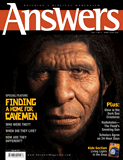Stones, Bronze, Iron
Hall of Life—Human Exhibits
on June 13, 2016Many museums feature depictions of prehistoric man in various settings, using various types of tools. Allegedly, the more primitive people used tools of stone, progressed to making tools of bronze, and culminated with making tools of iron.
However, from the Bible, we know that almost from the beginning, men were working with metals, and, thus, making tools of iron. The great-great-great-great-great grandson of Adam was Tubal-Cain, who was an “instructor of every craftsman in bronze and iron” (Genesis 4:22). And Noah must have used various types of tools to build his giant boat. Presumably, he would have passed his knowledge on to his sons, who taught their sons, and so on.
At Babel, the people quickly scattered. In rebuilding their lives elsewhere, some may have used the available materials—stones or wood—to fashion new homes. Later, they took more time to find ores and then smelt new metal tools and build other homes for themselves. Other family groups may have simply lacked the knowledge of how to work with metal, and only used what was nearby in their tool-making.
In fact, scientists have found that the Haya people of Tanzania were making medium-carbon steel in preheated, forced-draft furnaces long before Europeans began steelwork in the nineteenth century. For more information, see www.answersingenesis.org/archaeology/ancient-technology/ancient-steelmakers/.
Related Downloads
Ancient man—he had advanced technology!
Audio DownloadAncient beads—a surprise for many!
Audio DownloadAncient toothpaste . . . leaves teeth fresh and clean!
Audio DownloadThe Genius of Ancient Man Excerpt: Chapters 1–3
PDF DownloadMuseum Guide
Are you exasperated by all the hype about "millions of years" in secular museums? The Museum Guide will help!
Browse Kids BookRecommended Resources
- © 2025 Answers in Genesis
- Privacy Policy
- Contact
- About





